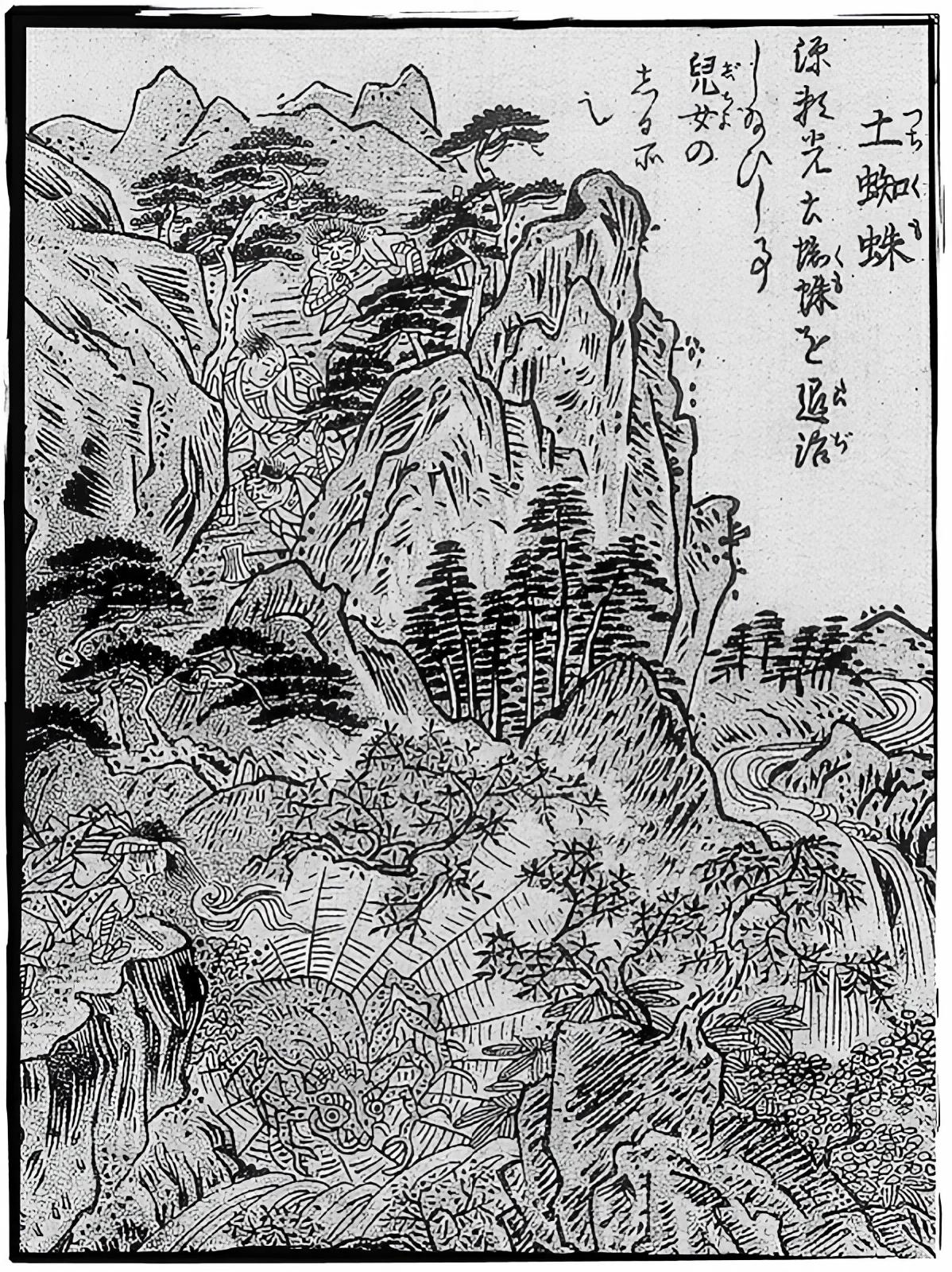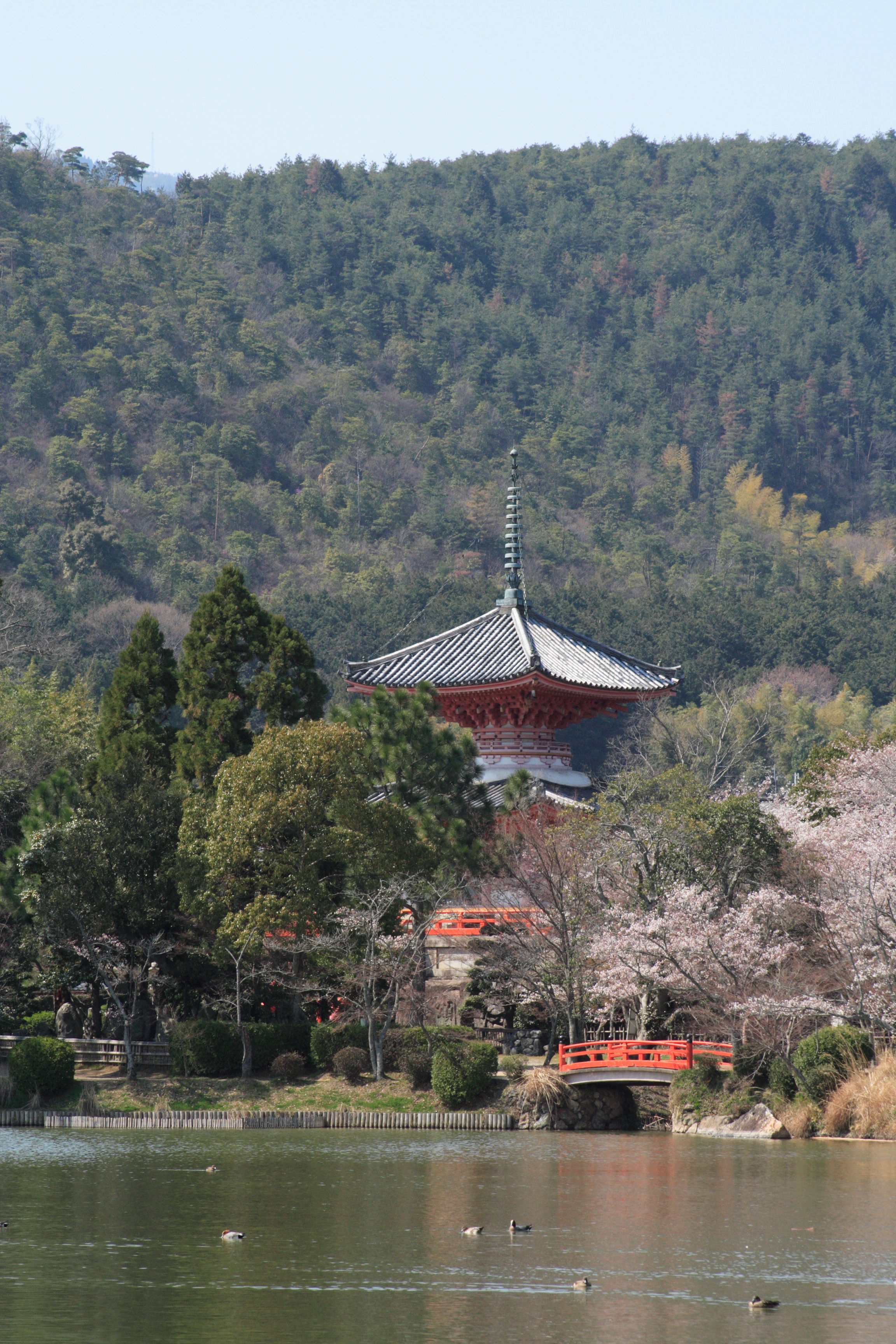|
Earth Spider
is a historical Japanese derogatory term for renegade local clans, and also the name for a race of spider-like yōkai in Japanese folklore. Alternative names for the mythological Tsuchigumo include and . In the '' Kojiki'' and in '' Nihon Shoki'', the name was phonetically spelled with the four kanji (for the four morae ''tsu-chi-gu-mo''), and these words were frequently used in the fudoki of Mutsu, Echigo, Hitachi, Settsu, Bungo and Hizen as well as others. The Japanese name for large ground-dwelling tarantulas, ōtsuchigumo, is due to their perceived resemblance to the creature of the myth, rather than the myth being named for the spider. Japan has no native species of tarantula, and the similarities between the mythical and the actual creature—huge wandering spiders with an obvious face that like to hide in burrows—were entirely coincidental. The fact that the later iterations of the myth specifically refer to the body being that of a tiger, however, does imply that ... [...More Info...] [...Related Items...] OR: [Wikipedia] [Google] [Baidu] |
Yamato Province
was a province of Japan, located in Kinai, corresponding to present-day Nara Prefecture in Honshū. Nussbaum, Louis-Frédéric (2005). "Yamato" in . It was also called . Yamato consists of two characters, 大 "great", and 和 " Wa". At first, the name was written with one different character (), but due to its offensive connotation, for about ten years after 737, this was revised to use more desirable characters () (see Names of Japan). The final revision was made in the second year of the Tenpyō-hōji era (c. 758). It is classified as a great province in the '' Engishiki''. The Yamato Period in the history of Japan refers to the late Kofun Period (c. 250–538) and Asuka Period (538–710). Japanese archaeologists and historians emphasize the fact that during the early Kofun Period the Yamato Kingship was in close contention with other regional powers, such as Kibi Province near present-day Okayama Prefecture. Around the 6th century, the local chieftainship gained nation ... [...More Info...] [...Related Items...] OR: [Wikipedia] [Google] [Baidu] |
Tachi
A is a type of traditionally made Japanese sword (''nihonto'') worn by the samurai class of feudal Japan. ''Tachi'' and ''katana'' generally differ in length, degree of curvature, and how they were worn when sheathed, the latter depending on the location of the ''mei'' (銘), or signature, on the tang. The ''tachi'' style of swords preceded the development of the ''katana'', which was not mentioned by name until near the end of the twelfth century. ''Tachi'' were the mainstream Japanese swords of the Kotō period between 900 and 1596. Even after the Muromachi period (1336–1573), when ''katana'' became the mainstream, ''tachi'' were often worn by high-ranking samurai. History The production of swords in Japan is divided into specific time periods: * ''Jōkotō'' (ancient swords, until around 900) * ''Kotō'' (old swords from around 900–1596) * ''Shintō'' (new swords 1596–1780) * ''Shinshintō'' (new new swords 1781–1876) * ''Gendaitō'' (modern or contemporary sw ... [...More Info...] [...Related Items...] OR: [Wikipedia] [Google] [Baidu] |
Hakone Shrine
The is a Japanese Shinto shrine on the shores of Lake Ashi in the town of Hakone in the Ashigarashimo District of Kanagawa Prefecture.Kotodamaya.com"Hakone Jinja" retrieved 2013-1-27. It is also known as the . Nussbaum, Louis-Frédéric. (2005)"Hakone Gongen-jinja"in ''Japan Encyclopedia'', p. 279. Enshrined ''kami'' The primary ''kami'' of Hakone Shrine are * * * They are known collectively as the . History According to shrine tradition, ''Hakone-jinja'' was founded in 757 during the reign of Emperor Kōshō. The original shrine was at the summit of the Komagatake peak of Mount Hakone. The shrine was relocated to the shores of Lake Ashi; its current form dates to 1667. Credit for establishment is also given to Priest Mangan, for pacifying the nine-headed dragon that lived at the bottom of Lake Ashi. According to the ''Azuma Kagami'', Minamoto no Yoritomo sought guidance and shelter from the kami at Hakone after his defeat in Battle of Ishibashiyama during the Genpei W ... [...More Info...] [...Related Items...] OR: [Wikipedia] [Google] [Baidu] |
Daikaku-ji
is a Shingon Buddhist temple in Ukyō-ku, a western ward in the city of Kyoto, Japan. The site was originally a residence of Emperor Saga (785–842 CE), and later various emperors conducted their cloistered rule from here. The '' Saga Go-ryū'' school of ikebana has its headquarters in the temple. The artificial lake of the temple, Ōsawa Pond, is one of the oldest Japanese garden ponds to survive from the Heian period. History The origins of the temple dates back to the Heian period in the year 814 CE, when Emperor Saga had a palace, known as the ''Saga-in'', constructed on the site. The palace later became his seat of retirement, known as ''Saga Rikyu'' imperial villa. According to tradition, when Japan suffered a serious epidemic, the Buddhist monk Kobo Daishi, the founder of Shingon Buddhism, suggested that the Emperor Saga personally copy an important Buddhist religious document called the Heart Sutra (''Hannya Shingyō''). The emperor made a handwritten copy, and ... [...More Info...] [...Related Items...] OR: [Wikipedia] [Google] [Baidu] |
Heike Tsuruginomaki
''Heike Tsuruginomaki'' (平家剣巻 "Heike Sword Scroll"), also called ''Heike Monogatari Tsuruginomaki'' (平家物語剣巻) is a Japanese ''gunki monogatari''. Overview Passed down in top secret among the ''biwa hōshi''—blind monks who played ''The Tale of the Heike'' on the '' biwa'' lute—the scroll is meant to take place in the eleventh book of the ''Tale'', following the chapter "The Sacred Mirror Enters the Capital" (内侍所都入) and in place typically occupied by a short chapter similarly entitled "Swords" (剣). The common version of the "Swords" text collects anecdotes ('' setsuwa'') about the sword Kusanagi, one of the imperial regalia, which had been lost at the Battle of Dannoura, and alleges that the great serpent Yamata no Orochi, slain in ages past by the storm god Susanoo no Mikoto who then retrieved the sword from the serpent's corpse, had taken the form of the boy emperor Antoku and reclaimed the sword. (This version of the text is believed to hav ... [...More Info...] [...Related Items...] OR: [Wikipedia] [Google] [Baidu] |
Genpei Jōsuiki
The , is a 48-book extended version of the ''Heike Monogatari'' (''The Tale of the Heike''). References External links at University of Virginia The University of Virginia (UVA) is a public research university in Charlottesville, Virginia. Founded in 1819 by Thomas Jefferson, the university is ranked among the top academic institutions in the United States, with highly selective ad ... Library Japanese chronicles Early Middle Japanese texts Gunki monogatari {{Japan-hist-stub ... [...More Info...] [...Related Items...] OR: [Wikipedia] [Google] [Baidu] |
Biwa
The is a Japanese short-necked wooden lute traditionally used in narrative storytelling. The is a plucked string instrument that first gained popularity in China before spreading throughout East Asia, eventually reaching Japan sometime during the Nara period (710–794). Typically to in length, the instrument is constructed of a water drop-shaped body with a short neck, typically with four (though sometimes five) strings. In Japan, the is generally played with a instead of the fingers, and is often used to play . One of the 's most famous uses is for reciting ''The Tale of the'' , a war chronicle from the Kamakura period (1185–1333). In previous centuries, the predominant musicians would have been , who used the as musical accompaniment when reading scriptural texts. The 's Chinese predecessor was the (), which arrived in Japan in two forms; following its introduction to Japan, varieties of the quadrupled. Guilds supporting players, particularly the , helped prol ... [...More Info...] [...Related Items...] OR: [Wikipedia] [Google] [Baidu] |
The Tale Of The Heike
is an epic account compiled prior to 1330 of the struggle between the Taira clan and Minamoto clan for control of Japan at the end of the 12th century in the Genpei War (1180–1185). Heike () refers to the Taira (), ''hei'' being the ''on'yomi'' reading of the first ''kanji'' and "ke" () means family. Note that in the title of the Genpei War, "hei" is in this combination read as "pei" and the "gen" () is the first kanji used in the Minamoto (also known as "Genji" which is also pronounced using ''on'yomi'', for example as in '' The Tale of Genji'') clan's name. It has been translated into English at least five times, the first by Arthur Lindsay Sadler in 1918–1921. A complete translation in nearly 800 pages by Hiroshi Kitagawa & Bruce T. Tsuchida was published in 1975. Also translated by Helen McCullough in 1988. An abridged translation by Burton Watson was published in 2006. In 2012, Royall Tyler completed his translation, which seeks to be mindful of the performance s ... [...More Info...] [...Related Items...] OR: [Wikipedia] [Google] [Baidu] |
Muromachi Period
The is a division of Japanese history running from approximately 1336 to 1573. The period marks the governance of the Muromachi or Ashikaga shogunate (''Muromachi bakufu'' or ''Ashikaga bakufu''), which was officially established in 1338 by the first Muromachi ''shōgun'', Ashikaga Takauji, two years after the brief Kenmu Restoration (1333–1336) of imperial rule was brought to a close. The period ended in 1573 when the 15th and last shogun of this line, Ashikaga Yoshiaki, was driven out of the capital in Kyoto by Oda Nobunaga. From a cultural perspective, the period can be divided into the Kitayama and Higashiyama cultures (later 15th – early 16th centuries). The early years from 1336 to 1392 of the Muromachi period are known as the '' Nanboku-chō'' or Northern and Southern Court period. This period is marked by the continued resistance of the supporters of Emperor Go-Daigo, the emperor behind the Kenmu Restoration. The Sengoku period or Warring States period, which b ... [...More Info...] [...Related Items...] OR: [Wikipedia] [Google] [Baidu] |
Kamakura Period
The is a period of Japanese history that marks the governance by the Kamakura shogunate, officially established in 1192 in Kamakura by the first ''shōgun'' Minamoto no Yoritomo after the conclusion of the Genpei War, which saw the struggle between the Taira and Minamoto clans. The period is known for the emergence of the samurai, the warrior caste, and for the establishment of feudalism in Japan. During the early Kamakura period, the shogunate continued warfare against the Northern Fujiwara which was only defeated in 1189. Then, the authority to the Kamakura rulers waned in the 1190s and power was transferred to the powerful Hōjō clan in the early 13th century with the head of the clan as regent ( Shikken) under the shogun which became a powerless figurehead. The later Kamakura period saw the invasions of the Mongols in 1274 and again in 1281. To reduce the amount of chaos, the Hōjō rulers decided to decentralize power by allowing two imperial lines – Northern and ... [...More Info...] [...Related Items...] OR: [Wikipedia] [Google] [Baidu] |







